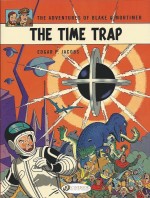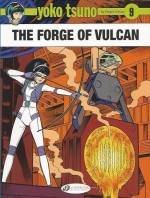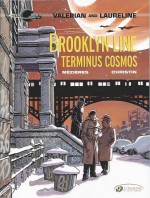
By Edgar P. Jacobs, translated by Jerome Saincantin (Cinebook)
ISBN: 978-1-84918-214-0
Pre-eminent fantasy raconteur Edgar P. Jacobs devised one of the greatest heroic double acts in fiction: pitting his distinguished Scientific Adventurers Professor Philip Mortimer and Captain Francis Blake against a wide variety of perils and menaces in a stellar sequence of stunning action thrillers which merged science fiction scope, detective mystery suspense and supernatural thrills. The magic was made perfect through his stunning illustrations rendered in the timeless Ligne claire style which had made intrepid boy-reporter Tintin a global sensation.
The Doughty Duo debuted in the very first issue of Le Journal de Tintin (26th September 1946): an ambitious international anthology comic with editions in Belgium, France and Holland. The magazine was edited by Hergé, with his eponymous star ably supplemented by a host of new heroes and features for the post-war world…
The Time Trap comes from a transitional period when the entire world seemed to be changing. The tale was originally serialised from January 8th 1958 to 22nd April 1959 and subsequently collected in a single album, as B & M’s eighth drama-drenched epic album escapade, six months after the conclusion. However, as befitted the times, this largely solo saga seemed to offer faster, leaner drama and stripped-down action in bigger, less dense panels…
It was only recently translated by Cinebook (2014 as their 19th Blake and Mortimer release), and begins here with the heroes relaxing in Paris when Mortimer gets a rather shocking message. Not long before, the incomparable boffin had been instrumental in foiling the plans of diabolical Professor Milosh Georgevich who used the vast resources of an aggressor nation to weaponise the weather (as seen in SOS Meteors) in advance of an audacious scheme to invade France, and now the villain has seemingly communicated from beyond the grave…
The literally mad scientist was believed to have perished and now word comes that he has bequeathed to Mortimer – the only man he considered an intellectual equal – his estate as well as his last and greatest invention…
With his naturally suspicious comrade called to Germany on another Secret Service errand, the Professor slowly motors alone down to rural La Roche-Guyon and – still looking for traps – cautiously inspects the 10th century house known locally as “The Bove of the Maiden†bequeathed to him by Milosh.
The idyllic setting, complete with haunted, legend-drenched castle, is not one to likely to set off any alarms in his bemused head…
What he finds in the deep cellars beneath his new property defies belief and comprehension. As described in recorded messages Georgevich had solved the mystery of time travel and, since he was dying of radiation poisoning, wanted his incredible device to be used by the only other person who could truly appreciate the scope of his genius…
In a daze the still sceptical Mortimer follows the taped instructions, donning the protective suit provided before activating the vehicle. Only as the “Chronoscaphe†rumbles into action and deposits him a terrifying antediluvian world of colossal plants, rampaging dinosaurs and marauding giant bugs does he realise how he has been tricked…
Against all his expectations the time machine works, landing him in a fantastic lost realm. Sadly the machine’s selector controls have been sabotaged, leaving Mortimer no way to return…
Devilish Milosh however has not counted on his dupe’s steely determination, expansive brilliance and sheer stubbornness, and before long the Professor is hurtling forward 100,000,000 years through eternity, roughly calculating in his shaggy head his original point of origin.
He’s not far off in his sums, relatively. The cellar is indeed the one he first found the Chronoscaphe in, but some time before Georgevich built his lab. Realising he needs to know the exact date before he can fine-tune his calibrations Mortimer works his way through the tunnels towards the surface and promptly finds himself in the midst of a feudal rebellion…
Gui de la Roche is not a benevolent overlord and is currently losing control of his lands to an uprising of his Serfs. The petty tyrant is understandably unhappy and suspicious when a strangely dressed Englishman drops into the middle of the conflict, babbling like a loon. The ill-educated peasants simply think he’s a demon…
Mortimer barely makes it back to the Chronoscaphe and in his haste overshoots his desired destination, encountering a few bizarre temporal manifestations as he plunges far into a dystopian future…
Finding himself embroiled in an all-out war to liberate mankind from an insidious global dictator, the Professor’s insights wedded to the technology of a broken future soon topple the tyrant and he thereafter adapts Tomorrow’s technology to solving his own problems.
With everything he needs to steer true a course home, the wily boffin even has an opportunity to turn the tables on the madman who caused his eccentric odyssey through the corridors of time…
Swift-paced, witty and spectacularly action-packed, this solo outing for Mortimer rockets from staggering sci fi set-piece to set-piece, building to an explosive conclusion with a tantalising final flourish, resulting in a superbly engaging blockbuster to delight every adventure addict.
This Cinebook edition also includes excerpts from two other Blake & Mortimer albums plus a short biographical feature and publication chart of Jacobs’ and his successors’ efforts.
Original edition © Editions Blake & Mortimer/Studio Jacobs (Dargaud-Lombard s. a.) 1962 by E.P. Jacobs. All rights reserved. English translation © 2014 Cinebook Ltd.











